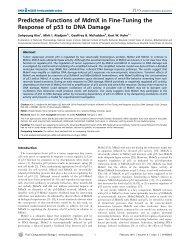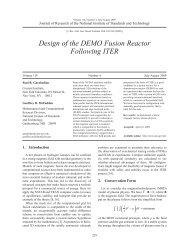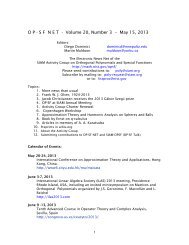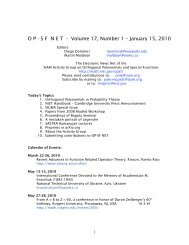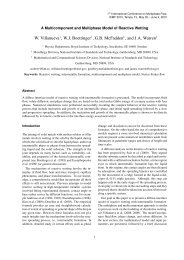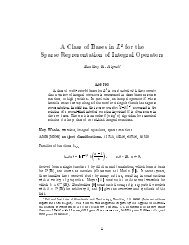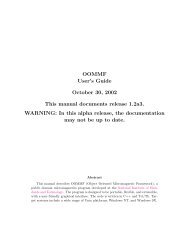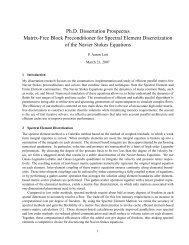PBIBD and its applications in Cryptology - Math, Statistics, and ...
PBIBD and its applications in Cryptology - Math, Statistics, and ...
PBIBD and its applications in Cryptology - Math, Statistics, and ...
You also want an ePaper? Increase the reach of your titles
YUMPU automatically turns print PDFs into web optimized ePapers that Google loves.
<strong>PBIBD</strong> <strong>and</strong> <strong>its</strong> <strong>applications</strong> <strong>in</strong> <strong>Cryptology</strong><br />
Bimal Roy<br />
Indian Statistical Institute<br />
www.isical.ac.<strong>in</strong>/∼bimal
In this talk ...<br />
We will first describe the comb<strong>in</strong>atorial framework of <strong>PBIBD</strong><br />
And then proceed to show <strong>its</strong> <strong>applications</strong> <strong>in</strong> <strong>Cryptology</strong><br />
1. Key Predistribution <strong>in</strong> Wireless Sensor Networks<br />
2. Traitor Trac<strong>in</strong>g <strong>in</strong> schemes with restricted access<br />
3. Secret Shar<strong>in</strong>g schemes us<strong>in</strong>g Visual Cryptography
Partially Balanced Incomplete Block Design<br />
(<strong>PBIBD</strong>)
Comb<strong>in</strong>atorial Designs<br />
A set system or design is a pair (X , A), where<br />
◮ X is the ma<strong>in</strong> set of elements<br />
◮ A is a set of subsets of X , called blocks<br />
Balanced Incomplete Block Design<br />
BIBD(v, b, r, k; λ) is a design which satisfy<br />
◮ |X | = v <strong>and</strong> |A| = b<br />
◮ Each block <strong>in</strong> A conta<strong>in</strong>s exactly k elements<br />
◮ Each element <strong>in</strong> X occurs <strong>in</strong> r blocks<br />
◮ Each pair of elements <strong>in</strong> X occurs <strong>in</strong> exactly λ blocks<br />
Example: BIBD(7, 7, 3, 3; 1) on set X = {0, 1, 2, 3, 4, 5, 6}<br />
A = {(1, 2, 4), (2, 3, 5), (3, 4, 6), (4, 5, 0), (5, 6, 1), (6, 0, 2), (0, 1, 3)}
<strong>PBIBD</strong>: Partially Balanced Incomplete Block Design<br />
PB [k; λ1, λ2, . . . , λm; v] is a design such that<br />
◮ There are b blocks, each of size k, on a v-set X<br />
◮ It is an association scheme with m associate classes<br />
◮ Each element of X has exactly ni number of i-th associates<br />
◮ Two i-th associate elements occur together <strong>in</strong> λi blocks<br />
Associates<br />
1-st 2-nd 3-rd<br />
1 2, 3 4 5, 6<br />
2 1, 3 5 4, 6<br />
3 1, 2 6 4, 5<br />
4 5, 6 1 2, 3<br />
5 4, 6 2 1, 3<br />
6 4, 5 3 1, 2<br />
Example: PB[3; 2, 2, 1; 6]<br />
X = {1, 2, 3, 4, 5, 6}<br />
v = 6, b = 8, r = 4, k = 3<br />
A = {(1, 2, 4), (1, 3, 4), (1, 2, 5),<br />
(1, 3, 6), (2, 3, 5), (2, 3, 6),<br />
(4, 5, 6), (4, 5, 6)}
<strong>PBIBD</strong>: Another example<br />
2-associate class <strong>PBIBD</strong><br />
1-st associates : Same row or column<br />
2-nd associates: Rest of the elements<br />
1-st associate of 6 : 1, 5, 7, 3, 8, 10<br />
2-nd associate of 6: 2, 4, 9<br />
Block 1: (2, 3, 4, 5, 6, 7) Block 2: (1, 3, 4, 5, 8, 9)<br />
Block 3: (1, 2, 4, 6, 8, 10) Block 4: (1, 2, 3, 7, 9, 10)<br />
Block 5: (1, 2, 6, 7, 8, 9) Block 6: (1, 3, 5, 7, 8, 10)<br />
Block 7: (1, 4, 5, 6, 9, 10) Block 8: (2, 3, 5, 6, 9, 10)<br />
Block 9: (2, 4, 5, 7, 8, 10) Block 10: (3, 4, 6, 7, 8, 9)
Application of <strong>PBIBD</strong> <strong>in</strong> Key Predistribution
Key Predistribution<br />
◮ Security of the WSN depends on efficient key distribution<br />
◮ PKC <strong>and</strong> ECC are too computation <strong>in</strong>tensive for WSNs<br />
◮ Thus we need distribution of keys <strong>in</strong> nodes prior to deployment<br />
Problem: Distribute node keys from key-pool {0, 1, 2, 3, 4, 5, 6}.
Metrics to evaluate Key Predistribution schemes<br />
General metrics:<br />
◮ Scalability: Allow post-deployment <strong>in</strong>crease <strong>in</strong> network size<br />
◮ Efficiency: Time taken for communication between nodes<br />
◮ Storage: Amount of memory required to store the keys<br />
◮ Computation: No. of cycles needed for key agreement<br />
◮ Communication: No. of messages sent for key agreement<br />
Security metrics:<br />
◮ Key Connectivity: The probability that two nodes share<br />
one/more keys should be high<br />
◮ Resiliency: Even if a number of nodes are compromised <strong>and</strong><br />
the keys conta<strong>in</strong>ed are revealed, the whole network should not<br />
fail, i.e., only a part of the network should get affected
Resiliency - an example<br />
V (s) = Fraction of nodes disconnected for s nodes compromised<br />
E(s) = Fraction of l<strong>in</strong>ks broken for s nodes compromised<br />
V (2) = 1/13 = 0.0769 <strong>and</strong> E(2) = (14 + 13 + 12)/105 = 0.371
Mapp<strong>in</strong>g <strong>PBIBD</strong> to Key Predistribution<br />
In this situation, we have n = 5, <strong>and</strong><br />
2-associate class <strong>PBIBD</strong><br />
1: (2, 3, 4, 5, 6, 7) 2: (1, 3, 4, 5, 8, 9)<br />
3: (1, 2, 4, 6, 8, 10) 4: (1, 2, 3, 7, 9, 10)<br />
5: (1, 2, 6, 7, 8, 9) 6: (1, 3, 5, 7, 8, 10)<br />
7: (1, 4, 5, 6, 9, 10) 8: (2, 3, 5, 6, 9, 10)<br />
9: (2, 4, 5, 7, 8, 10) 10: (3, 4, 6, 7, 8, 9)<br />
◮ Number of sensor nodes = n(n − 1)/2 = 10<br />
◮ Number of keys <strong>in</strong> key-pool = n(n − 1)/2 = 10<br />
◮ Number of keys <strong>in</strong> each node = 2(n − 2) = 6<br />
◮ Number of keys common to any two nodes = 4 or (n − 2) = 3
Advantages of the Design<br />
1. Number of keys per node is 2(n − 2), i.e., just O( √ N), when<br />
the size of the network is N = n(n − 1)/2.<br />
2. Any two nodes can communicate directly as they have at least<br />
one key shared among them.<br />
3. Resiliency is <strong>in</strong>creased <strong>in</strong> general, as follows.<br />
3.1 When two nodes <strong>in</strong> a row (or column) are compromised, then<br />
exactly one node will be disconnected (n > 5).<br />
3.2 Any two nodes compromised <strong>in</strong> different rows (or columns) will<br />
not disconnect any other node.<br />
3.3 If more than ⌈n/2⌉ + 1 nodes are compromised <strong>in</strong> total, then<br />
at least one node will be disconnected.<br />
3.4 Maximum number of nodes disconnected when s nodes are<br />
compromised is s(s − 1)/2 (when they are <strong>in</strong> a row/column).
Experimental Results<br />
Network Number Captured Affected Affected<br />
n size N of keys k nodes s nodes V (s) l<strong>in</strong>ks E(s)<br />
30 435 56 10 0.0753 0.3500<br />
40 780 76 10 0.0351 0.2510<br />
50 1225 96 10 0.0156 0.1800<br />
60 1770 116 10 0.0085 0.1314<br />
70 2415 136 10 0.0058 0.0724<br />
Scope:<br />
The values of V (s) <strong>and</strong> E(s) <strong>in</strong> the table are experimental data.<br />
◮ Is it possible to reduce the number of keys, but still improve<br />
the resiliency of the network?<br />
◮ How can we repeatedly apply the <strong>PBIBD</strong> schemes <strong>and</strong><br />
<strong>in</strong>crease the scalability of the network?
Application of <strong>PBIBD</strong> <strong>in</strong> Traitor Trac<strong>in</strong>g
Traitor Trac<strong>in</strong>g<br />
Situation:<br />
◮ Supplier distributes products for only authorized users to use.<br />
◮ Malicious authorized users (traitors) create pirated copies <strong>and</strong><br />
distribute them to unauthorized users.<br />
Goal of Traitor Trac<strong>in</strong>g:<br />
◮ Prevent authorized users to produce unauthorized copies.<br />
◮ Trace the source of piracy if unauthorized copies are created.<br />
◮ Trace traitors without harm<strong>in</strong>g the <strong>in</strong>nocent users.
Traitor Trac<strong>in</strong>g - Setup<br />
Setup: The distributor supplies each user Ui the follow<strong>in</strong>g:<br />
◮ A set of k personal keys denoted by P(Ui).<br />
◮ Enabl<strong>in</strong>g block to create session key s us<strong>in</strong>g personal keys.<br />
◮ The pla<strong>in</strong>text message encrypted us<strong>in</strong>g the session key s.<br />
Example: Number of users = 4, <strong>and</strong> Key pool = {000, 001, 010, 011, 100, 101}.<br />
P(U1) = {000, 010, 100} P(U2) = {000, 011, 101}<br />
P(U3) = {001, 011, 100} P(U4) = {001, 010, 101}<br />
Session key = 110. (obta<strong>in</strong>ed by b<strong>in</strong>ary addition of the keys modulo 2)<br />
No other comb<strong>in</strong>ation of keys can generate the same session key upon b<strong>in</strong>ary addition.<br />
{000, 001, 010} → 011, {000, 001, 011} → 010, {000, 001, 100} → 101,<br />
{000, 001, 101} → 100, {000, 010, 011} → 001, {000, 010, 101} → 111,<br />
{000, 011, 100} → 111, {001, 010, 100} → 111, {000, 100, 101} → 001,<br />
{001, 010, 011} → 000, {001, 011, 101} → 111, {001, 100, 101} → 000,<br />
{010, 011, 100} → 111, {010, 011, 101} → 100, {010, 100, 101} → 011,<br />
{011, 100, 101} → 010.
Traitor Trac<strong>in</strong>g - Action<br />
Piracy: Some users pool <strong>in</strong> their keys to make another valid key.<br />
Users U1, U2, · · · , Uc can collude <strong>and</strong> create a pirate decoder F .<br />
Trac<strong>in</strong>g:<br />
F ⊆ c<br />
i=1 P(Ui) <strong>and</strong> |F | = k.<br />
◮ If less than a certa<strong>in</strong> number of authorized users collude, the<br />
distributor can trace them us<strong>in</strong>g the key distribution scheme.<br />
◮ If more than this number of traitors collude, the distributor<br />
can not trace them without the risk of harm<strong>in</strong>g <strong>in</strong>nocent users.<br />
Problem: Design such a key distribution scheme for P(Ui).
c-Traceability Scheme<br />
Suppose there are b users Ui, each hav<strong>in</strong>g a share of k personal<br />
keys P(Ui). Let the size of the whole key pool be v.<br />
c-TS(v, b, k) is a c-traceability scheme if at least one traitor can<br />
be identified when a coalition of c or less traitors<br />
collude.<br />
c-FRTS(v, b, k) is a fully resilient c-traceability scheme if all the<br />
traitors can be identified when a coalition of c or less<br />
traitors collude.<br />
Problem: Design c-TS(v, b, k) or c-FRTS(v, b, k) us<strong>in</strong>g <strong>PBIBD</strong>,<br />
such that is supports large number of users b, small number of<br />
personal keys k, <strong>and</strong> large marg<strong>in</strong> c for trac<strong>in</strong>g traitors.
Example: 2-Traceability<br />
There are 25 users, <strong>and</strong> each is assigned 6 keys.<br />
The pirated set of keys is F = {0, 1, 2, 3, 6, 8}.<br />
P(B1) = {0, 1, 6, 18, 22, 29}, P(B2) = {0, 2, 3, 8, 20, 24},<br />
P(B3) = {1, 3, 4, 9, 21, 25}, P(B4) = {2, 4, 5, 10, 22, 26},<br />
P(B5) = {3, 5, 6, 11, 23, 27}, P(B6) = {4, 6, 7, 12, 24, 28},<br />
P(B7) = {5, 7, 8, 13, 25, 29}, P(B8) = {0, 7, 9, 10, 15, 27},<br />
P(B9) = {1, 8, 10, 11, 16, 28}, P(B10) = {2, 9, 11, 12, 17, 29},<br />
P(B11) = {0, 4, 11, 13, 14, 19}, P(B12) = {1, 5, 12, 14, 15, 20},<br />
P(B13) = {2, 6, 13, 15, 16, 21}, P(B14) = {3, 7, 14, 16, 17, 22},<br />
P(B15) = {4, 8, 15, 17, 18, 23}, P(B16) = {5, 9, 16, 18, 19, 24},<br />
P(B17) = {6, 10, 17, 19, 20, 25}, P(B18) = {7, 11, 18, 20, 21, 26},<br />
P(B19) = {8, 12, 19, 21, 22, 27}, P(B20) = {9, 13, 20, 22, 23, 28},<br />
P(B21) = {10, 14, 21, 23, 24, 29}, P(B22) = {0, 12, 16, 23, 25, 26},<br />
P(B23) = {1, 13, 17, 24, 26, 27}, P(B24) = {2, 14, 18, 25, 27, 28},<br />
P(B25) = {3, 15, 19, 26, 28, 29}.<br />
The 2 traitors B1 <strong>and</strong> B2 are uniquely traced.<br />
For 3 traitors: Confusion between {B1, B2, B3} <strong>and</strong> {B1, B2, B13}
Mapp<strong>in</strong>g <strong>PBIBD</strong> to Traitor Trac<strong>in</strong>g<br />
In this situation, we have n = 5, <strong>and</strong><br />
2-associate class <strong>PBIBD</strong><br />
1: (2, 3, 4, 5, 6, 7) 2: (1, 3, 4, 5, 8, 9)<br />
3: (1, 2, 4, 6, 8, 10) 4: (1, 2, 3, 7, 9, 10)<br />
5: (1, 2, 6, 7, 8, 9) 6: (1, 3, 5, 7, 8, 10)<br />
7: (1, 4, 5, 6, 9, 10) 8: (2, 3, 5, 6, 9, 10)<br />
9: (2, 4, 5, 7, 8, 10) 10: (3, 4, 6, 7, 8, 9)<br />
◮ Number of total users: b = n(n − 1)/2 = 10<br />
◮ Number of keys for each user: k = 2(n − 2) = 6<br />
◮ Number of keys <strong>in</strong> key-pool: v = n(n − 1)(n − 2)/2 = 30<br />
Identifiable collusion limit <strong>in</strong> this scheme is c = 2(n − 2) ≈ 2.
Our Result<br />
A 2(n − 2) − FRTS(n(n − 1)(n − 2)/2, n(n − 1)/2, 2(n − 2)) can<br />
be constructed from a [2; 0, 1; n(n − 1)/2]-<strong>PBIBD</strong>, when n ≥ 5.<br />
Previous example was for a 2 − FRTS(30, 10, 6) scheme (n = 5).<br />
Merit of the scheme:<br />
◮ For a system with N users, each user hav<strong>in</strong>g a set of O( √ N)<br />
keys, a collusion of at most O( 4√ N) traitors can be traced.<br />
◮ That is, for a set of 10,000 users, each user hav<strong>in</strong>g a set of<br />
100 keys, a collusion of at most 10 traitors can be traced.<br />
Scope: Improve bound of c compared to N (better than O( 4√ N)).
Application of <strong>PBIBD</strong> <strong>in</strong> Secret Shar<strong>in</strong>g
Secret Shar<strong>in</strong>g <strong>in</strong> Visual Cryptography<br />
Visual Cryptography: Naor <strong>and</strong> Shamir, 1994<br />
◮ Secret shar<strong>in</strong>g scheme with n participants, 1 secret image<br />
◮ Secret image to be split <strong>in</strong>to n shadow images called shares<br />
◮ Certa<strong>in</strong> qualified subsets of participants can recover the secret<br />
◮ Other forbidden sets of participants have no <strong>in</strong>formation
Example: (2, 2) Visual Cryptography Scheme<br />
Number of shares is n = 2, <strong>and</strong> 2 shares can recover the secret.<br />
Shares for Black pixel Shares for White pixel<br />
Construction of shares<br />
S 1 <br />
0 1<br />
=<br />
1 0<br />
<strong>and</strong> S 0 =<br />
0 1<br />
0 1
Problem Statement<br />
Construct a (m, n) Visual Cryptography Scheme (VCS) such that<br />
◮ There are n participants <strong>and</strong> 1 secret image<br />
◮ Secret image to be split <strong>in</strong>to n shadow images called shares<br />
◮ Any m-subset of participants can recover the secret<br />
◮ No t-subset of participants can recover the image if t < m<br />
In particular, we will construct a (2, n)-VCS <strong>in</strong> this talk.<br />
Metric: Relative Contrast<br />
If (2, n)-VCS has basis matrices S 0 , S 1 <strong>and</strong> pixel<br />
expansion m, then relative contrast for participants <strong>in</strong><br />
subset X is given by αX (m) = 1<br />
m (w(S 1 X ) − w(S 0 X )).
Mapp<strong>in</strong>g <strong>PBIBD</strong> to VCS<br />
Suppose there exists an (v, b, r, k, λ1, λ2)-<strong>PBIBD</strong>.<br />
It maps to a (2, n)-VCS with n = v, <strong>and</strong> pixel expansion m = b.<br />
Relative contrast <strong>in</strong> a subset X = {β, γ} of participants:<br />
◮ If β, γ are 1-st associates, αX (m) = 1<br />
m (r − λ1)<br />
◮ If β, γ are 2-nd associates, αX (m) = 1<br />
m (r − λ2)<br />
Mapp<strong>in</strong>g:<br />
1. Suppose N is the <strong>in</strong>cidence matrix of the <strong>PBIBD</strong>.<br />
2. Take share S 1 = N, which has r number of 1’s <strong>in</strong> each row.<br />
3. Construct share S 0 with all identical rows, with r 1’s <strong>in</strong> each.<br />
4. These shares S 0 , S 1 will make a (2, n)-VCS with n = v.
Example: <strong>PBIBD</strong> to VCS<br />
Let us have a (v = 6, b = 4, r = 2, k = 3, λ1 = 0, λ2 = 1)-<strong>PBIBD</strong><br />
◮ X = {1, 2, 3, 4, 5, 6} <strong>and</strong><br />
◮ A = {{1, 2, 3}, {1, 4, 5}, {2, 4, 6}, {3, 5, 6}}<br />
Construction of a (2, 6)-VCS<br />
S 1 ⎡<br />
1<br />
⎢ 1<br />
⎢<br />
= N = ⎢ 1<br />
⎢ 0<br />
⎣ 0<br />
1<br />
0<br />
0<br />
1<br />
1<br />
0<br />
1<br />
0<br />
1<br />
0<br />
0<br />
0<br />
1<br />
0<br />
1<br />
⎤<br />
⎥ <strong>and</strong> S<br />
⎥<br />
⎦<br />
0 0 1 1<br />
0 ⎡<br />
⎢<br />
= ⎢<br />
⎣<br />
1 1 0 0<br />
1 1 0 0<br />
1 1 0 0<br />
1 1 0 0<br />
1 1 0 0<br />
1 1 0 0<br />
Pixel expansion is clearly m = 4, from the rows of the shares.<br />
Relative contrast is either 1<br />
2<br />
or 1<br />
4 .<br />
⎤<br />
⎥<br />
⎦
Example: <strong>PBIBD</strong> to VCS<br />
Visual outcome of (6, 4, 2, 3, 0, 1)-<strong>PBIBD</strong> to (2, 6)-VCS<br />
Secret image:<br />
One Share<br />
Share 1:<br />
Share 2:<br />
Share 6:<br />
Two Shares<br />
Shares 1 & 6:<br />
Shares 1 & 2:<br />
Relative contrast is<br />
1<br />
1<br />
2 for 1 & 6 <strong>and</strong> 4 for 1 & 2
Thank You



